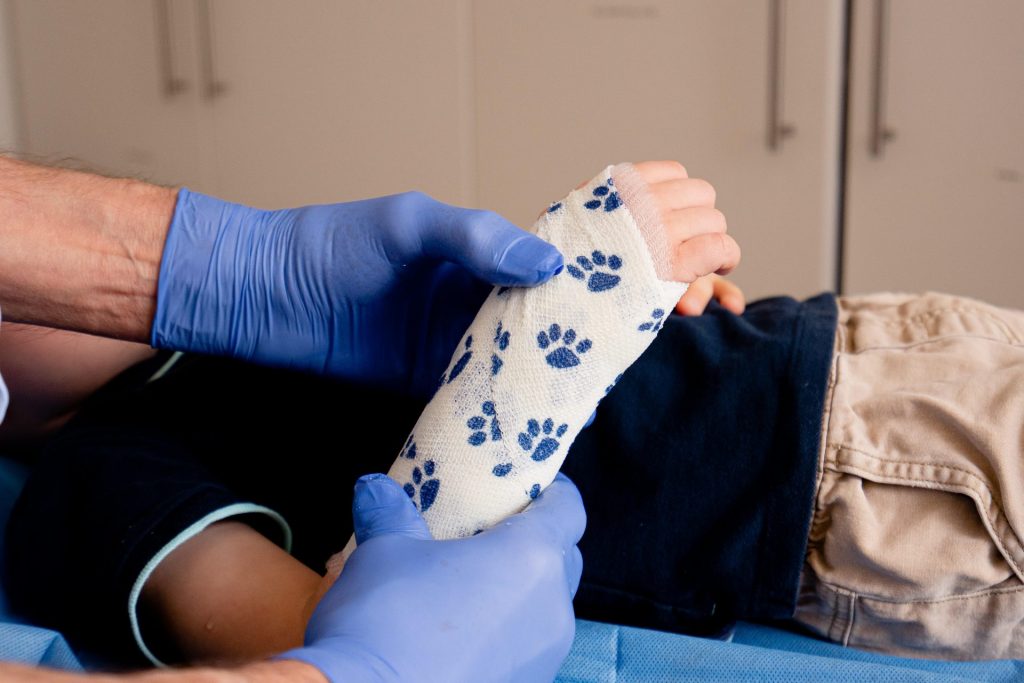
Paediatric Fractures
Fractures, or broken bones, are a common childhood injury. Paediatric fractures differ from those experienced by adults due to differences in anatomy and biomechanics and therefore benefit from specialised care.
Paediatric fractures can occur in any bone of the body but are most commonly seen in wrists, arms and elbows. Paediatric fractures include complete fractures, where the parts of the fractured bone are separated and the more common incomplete fractures, such as torus (buckle), greenstick and bowing fractures. When the fracture causes an open wound, this is called a compound fracture. While many fractures can be treated with a splint or cast, some fractures do require surgery. The good news is that paediatric fractures heal more quickly than adult fractures, generally mending in around 4 weeks.
Children’s Private Fracture Service
Orthopaedics SA provide a Children’s Private Fracture Service as a private alternative for the treatment of children with fractures. Our team of specialist orthopaedic surgeons can assess your child’s imaging remotely. If required, we can fit your child with a modern, waterproof cast at our private rooms – avoiding emergency departments. Priority appointments are available for fracture patients, please call 8267 8267 for an appointment. A referral from your GP is required to access this service.
Distal Radius fracture
This is the most common fracture among children under age 16, normally resulting from a simple fall on an outstretched hand and extended wrist. It usually involves the end of the bone near the wrist and can involve the growth plate (physis). Often the bones are not too bent and a simple waterproof cast is all that is needed. Angulated or displaced fractures may need a closed reduction under anaesthetic and casting.
Supracondylar fracture
These are the most common elbow fractures. Some require only a collar and cuff sling whereas angulated or displaced types are typically treated with closed reduction and percutaneous pinning. They are most common among children aged 5-10 years.
Mid-shaft forearm fracture
This fracture involves the diaphysis (midsection) of the radius and ulna. It generally results from a fall from height on an extended wrist and elbow. Treatment may involve closed reduction and casting.
Galeazzi fracture
The Galeazzi fracture is a fracture of the distal third of the radius with dislocation of the distal radio-ulnar joint. It requires surgery in adults, but children can often be treated with a closed reduction and splinting only. Most Galeazzi fractures will require an orthopaedic consultation.
Common signs of fracture include:
· Pain, tenderness or swelling in the injured limb
· Bruising or redness in the injured area
· Deformity/lump or bone protrusion
· Difficulty moving the injured limb, or keeping still to avoid movement
Common signs of fracture include:
- Pain, tenderness or swelling in the injured limb
- Bruising or redness in the injured area
- Deformity/lump or bone protrusion
- Difficulty moving the injured limb, or keeping still to avoid movement
Childhood fractures commonly occur from injury or trauma, such as falls or collisions during play and sport. Adelaide emergency departments are seeing an increasing amount of broken bones from bicycle accidents and home trampoline injuries. For tips on trampoline safety, read our trampoline safety advice.
Fractures are most commonly diagnosed using an x-ray, in some cases a CT or bone scan may be required. If you think your child has a fracture, visit your GP or hospital emergency department.
Fractures are usually treated with a splint or plaster cast. This reduces movement and allows the bones to mend. Modern casts are lightweight and waterproof and even available in a range of colours.
Surgery may be required in some cases. Pain relief, such as paracetamol, may be needed.
Tips for caring for you cast:
- Your cast has a hydrophobic lining (i.e., sheds water), so your skin will dry when wet
- Do NOT squirt liquid soap or shower gel down inside cast as it will irritate skin
- The cast may be wet under the shower unless advised NOT to do so
- You may also swim with your cast unless you have had surgery
- Wash the surrounding area of your cast carefully, checking for soreness or redness
- Do not poke or push anything down your cast as you could break the skin and cause an infection or cause the lining to bunch up & restrict drainage whilst wet
- Check daily for any cracks, breaks or weak areas in the cast
- Report if the cast is rubbing and if the cast has any weak areas.
- To promote circulation please keep all fingers and toes moving regularly – move all joints that are not enclosed in the cast
Report any of the following to your Specialist or one of the Practice Nurses:
- Persistent pain under your cast not relieved by pain killing medication or elevation
- Difficulty, pain or inability to move your fingers or toes
- Experience pins and needles or loss of feeling in your fingers or toes
- Marked swelling of your fingers or toes
- Fingers or toes become blue or white
- An unpleasant odour or burning sensation under the cast
- Cracks, breaks or weak spots within the cast
- Item becomes lodged under the cast or you are worried about the cast in any way
Book an appointment with our orthopaedic specialists
Book an appointment



